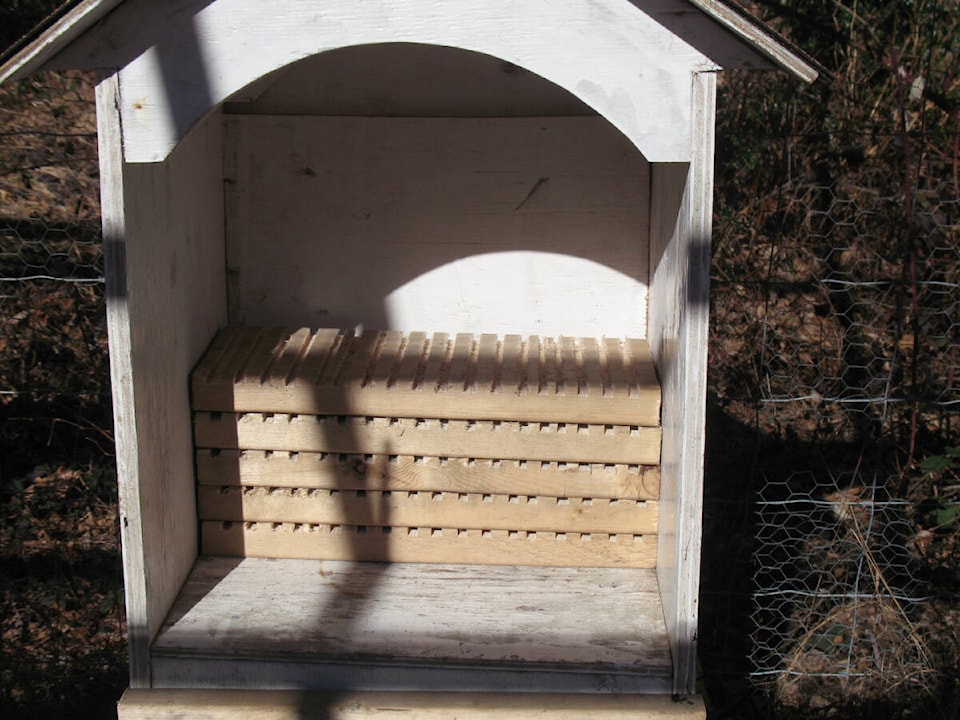By Mary Lowther
Some years ago David decided a few innocent remarks about the inadequate size of my garden justified buying an acreage across the street. He cleared some 300 alders, pulled an equal number of stumps, leveled the ground and fenced an acre or so, which seemed harmless enough and kept him busy for a long, long while. Since David without a project tends to get under foot this seemed like a good idea at the time.
When Geoffrey Chaucer claimed that Satan finds work for idle hands he must have had David in mind. I can’t claim I wasn’t warned, but I failed to understand what the Devil was going on when David asked so many questions about how I would create my own Garden of Eden that two of those hands were attached to my wrists! Thus came the day when I was presented with a large blank canvas and indelible proof that one should be careful what she asks for.
The first order of business was to plant fruit trees, which were espaliered along the north fence so they would not shade the rest of the crops. We planted apples, pears, cherries and nectarines, 20 of each because David believes you can’t have too much of a good thing. This is where we ran into our pollination problem.
I am sure we all heard about the birds and bees, so I’ll spare you the sordid details; those who don’t know them need to ask their parents. Until then, trust me when I tell you that without pollinators you can plant any number of fruit trees and get nothing but pretty flowers. If you want nectarines you must go about with a little brush and do it yourself, a very time consuming and boring job I had been doing for the few trees we already had. When I explained to David that I had neither time nor inclination to participate in a menage a quatre vingts it became obvious that we needed an alternative.
Have you ever read a fairy tale where the king gives his daughter’s suitors an impossible quest to win her hand? In David’s case this would be a very bad idea. David on a mission can get a bit carried away, so I should have been more careful about suggesting mason bees. First he researched mason bees and their predators, learning more about woodpeckers than any man should know, and built some arguably useful prototypes that I liked but failed to meet David’s exacting standards. It was looking like the princess would die single until he found someone who had mason bee larvae for sale. Eureka! Mounting his faithful Chevrolet, he dashed off into the sunrise and bought 50 cocooned little rascals. Of equal importance, he took a peek at their setup and brought the larvae home to move into a freshly constructed, five star mason bee hotel.
Of course, they had to wait in cold storage until the right moment, but he handled that by sticking them in the refrigerator between the potato salad and the cold cuts. Problem solved.
While I would prefer less variety on the deli shelf, I can see his point. With nary a bee last year we had no cherries, three nectarines and not a single apple. We had lots of pears because they’re self-pollinating. After all the labour involved and time expended David was living for the taste of fresh nectarine juice licked off his chin, and he was in no mood to be denied.
He has accepted responsibility for the entire process. He says he’ll do all the work: cleaning out the nesting tunnels, washing the bee pupae and keeping them cold and dark till next year. He must really, really love fresh nectarines.
Having seen a proper mason bee egg factory, David was in a bit of a sweat to get his version built before the eggs hatched in the refrigerator, but he got it done just in time. The native mason bees settled into the hole of the greenhouse door have just hatched and our chionodoxa are flowering. Overwintering brassicas like kale and broccoli produce early flowers that mason bees love, but they also love dandelions so I’m going to leave them until they start to go to seed. The books say that mason bees hatch on our West Coast around February, but since we’re three weeks behind Victoria they’re hatching now, in March. I was wondering if our bees, coming from the lowlands of Maple Bay, might hatch too early for our needs, but I googled it and learned that they emerge when the temperature is around 13 C and we’re just about there.
I’ve put a bucket of clay and water near the house so the bees can access the ingredients they need to build their nests; after all, that’s why they’re called mason bees. They take damp clay up to the nest and plug up each egg they lay with a ball of pollen for the pupa to eat, sealing it up in clay, each egg separately, then cap off all the eggs in the tunnel with a final dab of clay.
David is walking around today all smug and sassy. He hasn’t yet figured out that the reward for a job well done is another job.
Please contact mary_lowther@yahoo.ca with questions and suggestions since I need all the help I can get.
